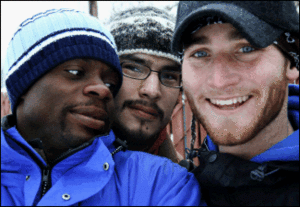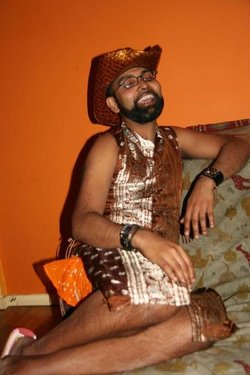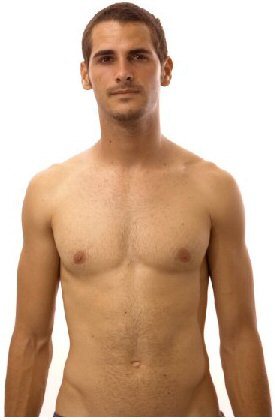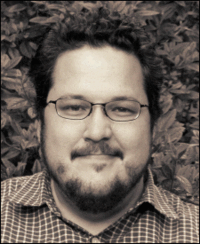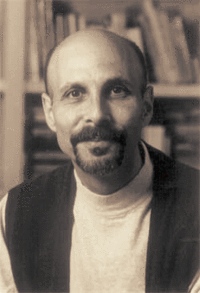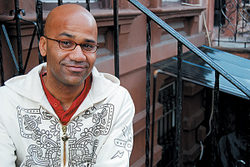 Drifting Toward Love
Drifting Toward Love
Black, Brown, Gay and Coming of Age on the Streets
A White Crane Conversation with Kai Wright
By Bo Young
This is only an excerpt…
As I sit to write this introduction, the radio is filled with discussion of the Sean Bell shooting in New York City. Sean Bell…Amadou Diallo…these are names that have entered the zeitgeist, the vocabulary in New York City out of pages of newsprint and the chattering class. The names mean: “shot to death at the hands of police.” While I must admit to an uncomfortable ambivalence about this case that, on one hand seems an story of over-reaction by the NYPD, and on the other a story of two Black officers, one Latino officer and young black men in a car used as in a way that could easily be interpreted as a weapon… I can readily say this: In a world of nuance I would not want to be a cop. In New York City or Los Angeles or Chicago, I would not want to be a young Black man…much less a Gay, young, Black man.
White Crane has an on-going commitment to the “generation conversation” and has, over the years, dedicated a number of issues to a variety of approaches to the subject. If we truly are a “community” one of the more uncomfortable facets of the generation conversation is how we take care of our children. “Children” is not a subject easily broached in a community that flinches with the expectation of predatory accusations as soon as the subject is brought up. And we’re not speaking of adoptive family structures, or the occasional “look-how-far-we’ve-come” story of a same-sex couples attending high school proms or drag “Prom Queens” or “Prom King.”
While the advances that have been accomplished in GLBT civil rights have been nothing short of remarkable in the past 30+ years, GLBT children largely still live in isolation, in hostile environments. Suffice it to say, if it’s difficult for a U.S. Senator to come to terms with his sexuality, imagine a 15-year-old living in Boise. In a country that still struggles with a separation of church and state and oppresses anything other than hetero-normative sex, our young people remain alone on the front lines. Drive down the mean streets of any major American city and it is impossible to miss the numbers of vagrant youth you see. San Francisco, San Diego, Miami, Phoenix and other warm climate cities are particularly highly populated and it becomes almost impossible to walk down the streets without being panhandled or solicited in some manner.
It is impossible to count precisely how many itinerant youth there are on the streets of U.S. major cities. These young people—mostly African-American or Latino, often homeless, but more likely from poor and working-class families—are what policy-makers and social services agencies refer to as “at-risk.” At risk youth rank among the most likely to experience the wide range of social ills: suicide, drug addiction, dropping out of school, hate crimes and HIV infection. Indeed, according to the recent CDC reports, data from 33 states indicates that new HIV or AIDS diagnoses among African-American Gay and bisexual men aged 13 to 24 went from just under 1,000 cases in 2001 to more than 1,600 cases in 2005. In New York City, the NYC Health Department found that in the past six years, new HIV diagnoses have doubled among men ages 13 to 19. Service providers have long estimated that GLBT youth account for 20 to 40 percent of people without homes. Recent studies have found that more than 25 percent of Gay youth surveyed drop out of school, citing harassment as the lead reason.
Drifting Toward Love: Black, Brown, Gay and Coming of Age on the Streets of New York is Kai Wright’s new book that explores these stark realities. In it, he explores the lives of three young Gay men living in Brooklyn, New York. Through a harrowing and often touching narrative he puts the broad debate about sexual politics and generation conversation into the context of real lives. And at the same time provides important insight into the difficult choices we all as we come of age as individuals and as a community. We spoke with Wright about his book.
Bo Young: Kai, how long did you work on Drifting Towards Love?
Kai Wright: In many ways I started working on the book at the start of my career, while reporting for the Washington Blade newspaper ten years ago. One of the first stories I wrote was about the challenges of reconciling racial and sexual identities and how that affects the “risks” we take and face as Gay men of color.
I have written story after story about how at-risk we are for everything from HIV to violence, and I’ve found it frustrating the way we talk and think about risk—as a set of narrow, disembodied choices, removed from broader life context. So the book was an effort to take all of the reporting I’ve done on risk-taking in the lives of Gay men, particularly Gay men of color, and put it back into the context of real life. Then, as I searched for people to profile and build a narrative around, I found that the story kept getting in the way. The young people I write about have terribly volatile lives, where they’re heading along OK one day and their world turns to chaos the next. So I’d meet someone once or twice and hit it off but then lose track of him or her. That was the tough part. The three guys the narrative focuses on turned out to be the three that stayed around the longest. And for them, the timing varied but I talked to them off and on for a little over a year.
Bo: What is your background? And how did you go about building trust with these young people? What are your authorial/cultural antecedents, if you will? Whose writing on these subjects did you find useful?
Kai: I’m not sure I can offer any insight on my authorial antecedents—there are likely too many to list! But I have to say that part of what motivated me to write the book is how little has been written about young Gay folks period, certainly those of color, that isn’t academic or self-help. There’s a real paucity of accessible, journalistic discussion about Gay life in general, actually. Our discussions are narrowly focused on either the political or public health challenges Gay folks present, rather than on real Gay lives. And perhaps because of that, there’s also this obsession with closeted or “down low” Gay men of color that crowds out conversation about far larger ranks of us who are trying to live out, healthy lives but who face real external barriers to doing so. So I wanted to offer narrative-driven, relatable stories about an experience that gets little airtime, if you will, and tell those stories from the protagonists’ perspectives rather than from the perspective of a researcher or an activist.
Bo: How did you meet the subjects that “stuck around” from the Christopher Street pier story, as you put it?
Kai: Ultimately, the guys in the book ended up being people with who were close to someone I had a connection with as well. Each of them spent significant time at the house in East New York and developed close connections with one of the owners. And I had personal connections there as well, and that allowed me to both keep up with the guys and gain their trust. I’m sure it helped that I’m a black Gay man myself, and was able to identify with a lot of the themes in their lives, if not the specific circumstances.
Bo: Are you still in touch with them? And have they seen the book, and what has their response been to the book, if any?
Kai: I’m still closely in touch with Manny, and he’s doing marvelously. He has continued to parlay his contrarian streak into paid work as a community organizer, and despite never going back to high school is doing well in that realm today. Though, he’s still leading a somewhat boxed-off life—most folks he works with have no idea about his not-so-distant history and the rough path he’s traveled. He does love the book though, or tells me he does at least. That’s rewarding because, again, I wanted to give him and the others a chance to speak for themselves. So often we just speak about them.
Julius, on the other hand, disappeared before I finished reporting the book, and I haven’t spoken to him since. Only one person I know of from his life here in NYC has been in touch with him and she declines to offer details. But she confirms that things have not turned out well, thus far, for Julius. He’s such a brilliant guy, but it sounds like the accumulated emotional trauma has caught up with him. I haven’t been in touch with Carlos, but I understand he’s still in East New York trying to sort out living there as an out Gay man.
Bo: Statistics show that 25 to 40% of homeless kids are LGBT…that’s just staggering. You do a pretty dead on job of assessing Covenant House, I thought…Who, do you think is out there doing innovative work with these young Gay homeless populations?
Kai: Well, I think the Ali Forney Center here in NYC has the right approach, and there may be others nationally that I’m not familiar with. They really try to deal with the problem holistically, not just placing youth in housing but really working with them on life skills ranging from holding a job to dating. They’ve just launched a neat “coaching” program that pairs groups of Gay adults with cohorts of the youth in their apartments for a series of seminars and activities. I think that sort of thing is right on-finding innovative ways to get Gay adults involved in their lives. I also just heard of a neat web initiative that the Trevor Project is launching. The Trevor Project is a mental health hotline for LGBT kids, with all sorts of resources for them to call and/or access when in crisis. But they’re starting a Gay youth social networking site called TrevorSpace.org that is trying to connect with youth before they reach the point of crisis. I think that’s important. So much of what’s out there is only available once you’re homeless or HIV infected or at death’s door in one way or another. This is a project to build support and community before there’s a problem.
But the tragedy is that there’s just not enough work going on in the Gay community period on this issue. The need is simply overwhelming, as the stats show, and yet the resources are meager. From money to volunteers to political priorities, I think we really have failed our youth. There are myriad reasons for that and real challenges here, but the community nationally and locally has proven an ability to make progress on seemingly intractable problems when we focus on them. It’s time we take responsibility for these young people.
Bo: What kind of response have you had in the Gay press about the book?
Kai: I think a really positive one. The folks who have taken interest in the book have been generally moved by the stories and have had lots to say about what we can and should be doing as a community to support these sorts of guys. So I’m heartened to see that there’s at least a willingness—and in some cases a hunger—to talk about these issues.
Bo: I frequently struggled, as I read, to differentiate between what in the stories were particular to being Gay and what was particular to being Black or brown, bicultural issues, inner city vs small town innocent stories. I’m not suggesting in any way that racism is not a factor in their lives, but by the same token, there were so many places where I kept thinking “that’s exactly what it was like for me when I was coming out” and I came out thirty years before these kids were even born! And I didn’t have the internet. I grew up in a small suburban town in one of the most Republican counties in America and I remember driving around as soon as I got my driver’s license trying to find one of these “Gay bars” I’d heard about, and never finding one. I’ve gone back to this day and not found one. I grew up thinking, until I was almost 21 years old, that I was the only Gay person in the world and feeling every bit as disconnected as these kids, but without any of the hints they all seemed to find so readily these days as a result of the last thirty plus years of LGBT civil rights work. I was struck with how quickly each of them were able to identify other Gay people in their lives, for example. And how they were able to connect with things like YES and whathaveyou. In many ways, the most striking gap, the more affecting gap in the stories you tell seem to be more about economics than about race. Can you comment on that?
Kai: I’d say the fact that these stories, all of which are set in the last few years, are so familiar to your experiences 30 years ago speaks volumes; these last 30 years of Gay civil rights work have helped some more than others. And the point I want to make is based on outcomes:
Clearly, young black and Latino Gay men are consistently at the top of the list of people who end up facing terrible outcomes ranging from HIV infection to homelessness. Nine out of 10 HIV infections among Gay men under 20 in NYC in 2006 were black or Latino. 90 percent! Is it class? Is it race? Is it geography? It’s all of the above. But to dismiss the role race plays, given the numbers, is wishful thinking. The theory I push in the book is that these disparities are directly related to the search for space in a world that offers them so little of it. Yes, their challenges are universal-not just to Gay folks, but to all people. We all go through the process of first defining ourselves and then finding a place in which the self we’ve defined can exist and be loved. The difference is that the young people in this book have such extraordinary barriers at both steps, and have so few resources to deploy in overcoming those barriers.
But I’d also avoid comparing states of oppression. The book’s point is to describe an experience that gets very little meaningful attention either inside or outside of the Gay community, and race is an important part of that experience, though clearly not all of it. And my critique of the Gay community is that it has done little to welcome and meaningfully support guys like Manny, Julius and Carlos. The same can be said for a whole lot of other folks, sure, but I’m interested in the unique experience of being black or Latino and trying to find room to be Gay. For all the Gay space that exists in NYC, it is not universally accessible—it’s overwhelmingly white, middle class and 18 and up. So ultimately, what I hope readers take away from this book is an understanding that it’s insufficient to carve out Gay ghettos that aren’t accessible to vast swaths of the community. And that’s not just a critique of the mainstream Gay community, but also of the burgeoning black Gay community. If we just recreate the middle class utopias of Chelsea and Dupont Circle in black face, I’m not sure we’ve achieved anything. Someone’s got to start building space in places like East New York, too.
Bo: I heard an interview where you talk about how there’s no boutiques in East New York, and none of the Gay press etc. How is that different from a Gay black kid growing up in rural Tennessee or Georgia, for example?
Kai: I’m not sure it is. But part of what’s compelling about setting the story in NYC is that it contrasts with the notion that there’s a mythical Gay promised land out there that we can all escape into. One of the most striking things I came across was in Carlos’ life. Here’s a young Puerto Rican man who’d lived his whole life in Brooklyn. And throughout the entirety of his life, one of the largest Gay pride rallies in the world unfolded a 30 minute subway ride from his front door. But he was in his early 20s before he ever noticed the thing. That says something about the distance that exists between the Gay community and people like Carlos, and that distance has little to do with geography.
This is just an excerpt from this issue of White Crane. We are a reader-supported journal and need you to subscribe to keep this conversation going. So to read more from this wonderful issue SUBSCRIBE to White Crane. Thanks!
Kai Wright is a writer and editor living in Brooklyn, NY whose work explores the politics of sex, race and health. Wright has reported from all over the world for independent and community-based media, ranging from Mother Jones to Essence magazines. He has also written and edited series of monographs exploring the AIDS epidemic among African-Americans, published by the Black AIDS Institute. He is the author of two books of African-American history: Soldiers of Freedom: An Illustrated History of African Americans in the Armed Forces, and The African-American Archive: The History of the Black Experience through Documents.
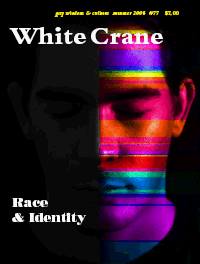 White Crane Issue #77
White Crane Issue #77